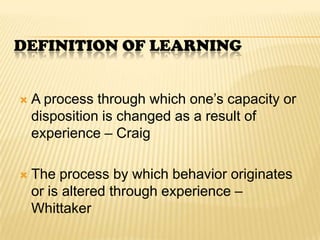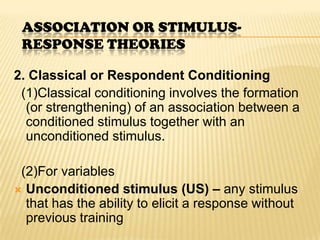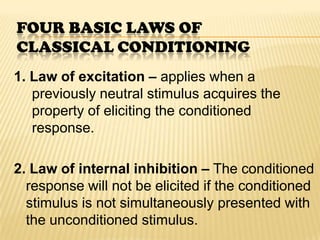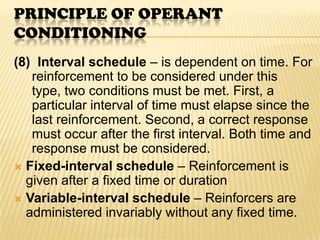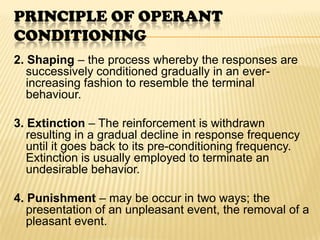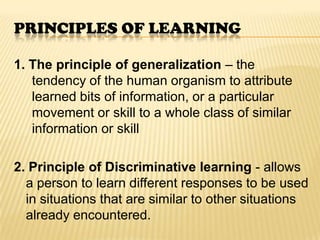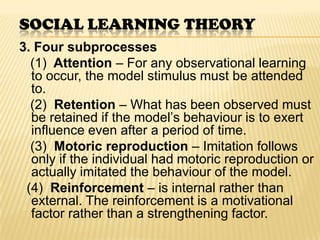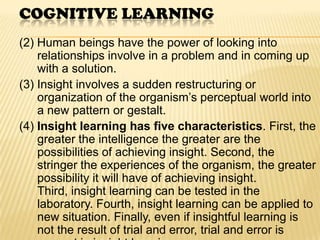Learning presentation
- 2. DEFINITION OF LEARNING ï A process through which oneâs capacity or disposition is changed as a result of experience â Craig ï The process by which behavior originates or is altered through experience â Whittaker
- 3. DEFINITION OF LEARNING ï A relatively permanent change in behavior that occurs as a result of experience â Witting and Hilgard ï Changes resulting from development and experience are emphasized; changes resulting from maturation such as growing, innate tendencies like reflexes and conditions caused by fatigue, drugs and diseases are strictly not considered as learned behavior.
- 4. THEORIES OF LEARNING ï The association or stimulus-response (SR) theories â emphasize the establishment and strengthening of relationships between the stimulus (S) and the response (R) and emphasize the role of reinforcement in the learning process. ï The non-association or cognitive theories â do not see learning as just a stimulus-response interaction. They focus on the cognitive structures of man as a basis for learning.
- 5. ASSOCIATION OR STIMULUS- RESPONSE THEORIES 1. Thorndlikeâs connectionism (1)Man learns by trial and error. (2)Man learns the act which leads to a âsatisfactory state of affairsâ and eliminates those which do not. (3)Two Laws of Learning ï The law of exercise â states that stimulus-response (SR) connections are strengthened by practice or repetition ï The law of effect â states that the SR bound or connections are strengthened by rewards or
- 6. ASSOCIATION OR STIMULUS- RESPONSE THEORIES 2. Classical or Respondent Conditioning (1)Classical conditioning involves the formation (or strengthening) of an association between a conditioned stimulus together with an unconditioned stimulus. (2)For variables ï Unconditioned stimulus (US) â any stimulus that has the ability to elicit a response without previous training
- 7. ASSOCIATION OR STIMULUS- RESPONSE THEORIES ï Conditioned stimulus (CS) â a stimulus which initially does not elicit the response under study but comes to do so by being paired with the unconditioned stimulus ï Unconditioned response (UR) â the original response to an unconditioned stimulus ï Conditioned response (CR) â the learned response to a conditioned stimulus
- 8. FOUR BASIC LAWS OF CLASSICAL CONDITIONING 1. Law of excitation â applies when a previously neutral stimulus acquires the property of eliciting the conditioned response. 2. Law of internal inhibition â The conditioned response will not be elicited if the conditioned stimulus is not simultaneously presented with the unconditioned stimulus.
- 9. FOUR BASIC LAWS OF CLASSICAL CONDITIONING 3. Law of external inhibition â Excitatory or inhibitory processes in conditioning can occur when new and distracting stimuli are presented and then removed. 4. Extinction â It occurs when the conditioned response is no longer elicited by the conditioned stimulus because the conditioned stimulus was constantly presented alone without the paired stimulus.
- 10. OTHER CONCEPTS INVOLVED IN CLASSICAL CONDITIONING 1. Stimulus generalization â The conditioned response can be elicited not only by the original conditioned stimulus but only other stimuli similar to the conditioned stimulus. 2. Spontaneous recovery â A conditioned response which does not appear for some time re-occurs without further conditioning.
- 11. OTHER CONCEPTS INVOLVED IN CLASSICAL CONDITIONING 3. Higher order conditioning â the process by which a conditioned stimulus may become an unconditioned stimulus.
- 12. PRINCIPLE OF OPERANT CONDITIONING 1. Reinforcement (1) Anything that increase the probability that a particular response will increase in frequency (2) Response may be reinforced by the presentation (positive) or removal (negative) of particular consequences. Positive and negative reinforces do not connote âgoodâ or âbadâ. (3) Primary reinforces - satisfy basic
- 13. PRINCIPLE OF OPERANT CONDITIONING (4) Secondary or conditioned reinforces â are not innately reinforcing. (money, grades, and praise) (5) A single reinforce is not reinforcing for long periods due to satiation. Satiation refers to the process whereby the effectiveness of a reinforce decreases with repeated presentation. (6) Continuous schedule â The reinforcement follows every correct response. This seems to be the quickest way to teach a new response. Only correct responses are to be reinforced.
- 14. PRINCIPLE OF OPERANT CONDITIONING (7) Ratio schedule â Reinforces are given only after a particular number of responses have been made. ï Fixed-ratio schedule â If a reinforce is given after a definite number of correct responses. ï Variable-ratio schedule â When the reinforcement is given after a varying number of responses.
- 15. PRINCIPLE OF OPERANT CONDITIONING (8) Interval schedule â is dependent on time. For reinforcement to be considered under this type, two conditions must be met. First, a particular interval of time must elapse since the last reinforcement. Second, a correct response must occur after the first interval. Both time and response must be considered. ï Fixed-interval schedule â Reinforcement is given after a fixed time or duration ï Variable-interval schedule â Reinforcers are administered invariably without any fixed time.
- 16. PRINCIPLE OF OPERANT CONDITIONING 2. Shaping â the process whereby the responses are successively conditioned gradually in an ever- increasing fashion to resemble the terminal behaviour. 3. Extinction â The reinforcement is withdrawn resulting in a gradual decline in response frequency until it goes back to its pre-conditioning frequency. Extinction is usually employed to terminate an undesirable behavior. 4. Punishment â may be occur in two ways; the presentation of an unpleasant event, the removal of a pleasant event.
- 17. PRINCIPLES OF LEARNING 1. The principle of generalization â the tendency of the human organism to attribute learned bits of information, or a particular movement or skill to a whole class of similar information or skill 2. Principle of Discriminative learning - allows a person to learn different responses to be used in situations that are similar to other situations already encountered.
- 18. PRINCIPLES OF LEARNING 3. Principle of reinforcement schedule â refers to the retention or learned skills without the need for further coaching or rewards. (1) Continuous rewards which entail that in the beginning of trained; a person is rewarded every time the proper response is elicited. (2) Intermittent rewards involves providing praise or reward at regular intervals (3) No reward should be given once the skill has already been acquired. 4. Principle of imitation and identification â involves learning desired behaviours by observing others who deliberately or inadvertently demonstrate the responses
- 19. SOCIAL LEARNING THEORY 1. Albert Bandura and Richard H. Walter believe that there is a reciprocal relationships between behaviour and the conditions that control it. Their theory also maintains the importance of the stimulus-response connection in social learning. 2. Modeling and imitation â Human beings learn from the models they are exposed to. Children who often see aggressive behaviour display more aggressive behaviour than those who are not exposed to such behavior. The age, sex, and status of subjects are also crucial factors. Imitation involves copying the behaviour of the mode one is exposed to.
- 20. SOCIAL LEARNING THEORY 3. Four subprocesses (1) Attention â For any observational learning to occur, the model stimulus must be attended to. (2) Retention â What has been observed must be retained if the modelâs behaviour is to exert influence even after a period of time. (3) Motoric reproduction â Imitation follows only if the individual had motoric reproduction or actually imitated the behaviour of the model. (4) Reinforcement â is internal rather than external. The reinforcement is a motivational factor rather than a strengthening factor.
- 21. COGNITIVE LEARNING 1. This theory focuses on the cognitive structured rather than on stimulus-response connections as the crucial factors in learning. 2. Insight learning (1) Wolfgang Kholer believed that animals are capable of intellectual accomplishments other than trial-and-error learning that Thorndlike proposed. He maintained that animals are able to see relationships between objects and events and act accordingly to achieve their ends. He believed that animals can have a clear and immediate understanding of the solution to a problem that presumably does not involve trial-and- error learning.
- 22. COGNITIVE LEARNING (2) Human beings have the power of looking into relationships involve in a problem and in coming up with a solution. (3) Insight involves a sudden restructuring or organization of the organismâs perceptual world into a new pattern or gestalt. (4) Insight learning has five characteristics. First, the greater the intelligence the greater are the possibilities of achieving insight. Second, the stringer the experiences of the organism, the greater possibility it will have of achieving insight. Third, insight learning can be tested in the laboratory. Fourth, insight learning can be applied to new situation. Finally, even if insightful learning is not the result of trial and error, trial and error is
- 23. COGNITIVE LEARNING 3. Sign Learning (1) Sign learning is defined as and acquired expectation that one stimulus will be followed by another in a particular context. (2) Behavior is goal-oriented and defined by a purpose. It is either going towards something or getting away from something. (3) Cognitive learning is usually more than the gathering of information; it involves new ways of learning, acting, and evaluating.
- 24. TRANSFER OF LEARNING 1. Learning to learn â experiments with verbal learning show that subjects increase their speed in learning word lists over a period of days. This is seen when the words are not similar, and indication that during the learning process, the subjects develop a technique that facilitates subsequent learning. 2. Mastery of principles â when principles are mastered, it will be easy to apply them to new situations. The principles learned in radio repairing, if mastered, may easily facilitate the learning of other tasks.


